From Art School to Publication: Why Having an Agent is Key III
last updated 22 July 2016
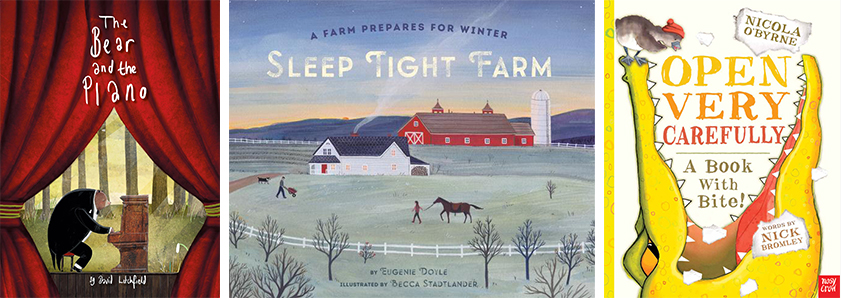
Bright Group International has been an illustration agency for over 13 years. Beginning from a tiny bedroom in Clapham, Bright Founder and MD Vicki Willden-Lebrecht made it her mission to champion artists and illustrators, to help them become the best they could possibly be and to propel those creators of children’s books back into having ‘rock star’ recognition in a world where digital was fast becoming the thing. The ethos is that a book must be valued as a beautiful creation, unlike anything the digital world can offer. There is no doubt that there will always be a place for children’s books in physical form — there’s just something about a book isn’t there?
In this last part of our mini blog, we talk about artistic development, art school and the benefits of being with an agency like Bright. We also touch on the different illustration markets — a skilled illustrator can cover many areas, allowing a wealth of opportunity across all kinds of subjects and genres.
The Illustrators: David Litchfield, Nicola O’Byrne, Becca Stadtlander
How did you take development? Did you find it easy to take direction, or did you feel that as the artist it should be up to you to take the lead on composition and layout etc?
[Nicola] I have only worked on one project that arrived in my inbox with the layouts all in place, and I did not do well on it. I ended up re-roughing it the way I thought it should look, and the publisher was much happier the second time around. Having said that, I do love direction and development. I am happy to try something different. The publisher has many years of experience, with insights I might never think of, and unless you push yourself you can end up stagnating with the same compositions… so I like to supply the first round of thumbnails and then get feedback and re-work them. Constructive feedback about your work is not personal. Sometimes I get feedback that is difficult to hear, but everyone wants the same thing — a book that is the best it can be — and if you feel differently about how something should be, try it both ways and discuss.

Draft illustrations from Nicola O’Byrne’s sketchbooks — to the final artwork in the published picture books with acknowledgements to Nosy Crow, Bloomsbury and Mark Sperring).
[Becca] I can get sort of stumped when I have too much direction, especially if it’s something I wouldn’t have thought of, or that doesn’t suit my aesthetic. I’ve had a few odd jobs that just weren’t right for me to begin with. But on the other hand, if a client knows exactly what they want, is clear about it, and trusts you to deliver, it’s almost always a slam-dunk. I love doing children’s books for that reason. All I have is the manuscript and total freedom. It’s scary at first, but always rewarding.
Working with Anne Moore Armstrong is pretty great. She has a good understanding of what kind of jobs will suit me, what my strengths are, and what I need to work on. I’ve been very happy with the things she’s sent my way. She’s encouraging and supportive of my ideas, but she doesn’t push me too hard. I communicate with her on a weekly basis, more or less depending on what jobs I have going on. She has so much experience in the industry, and I think having her on my side has been the key to breaking into the children’s book world.
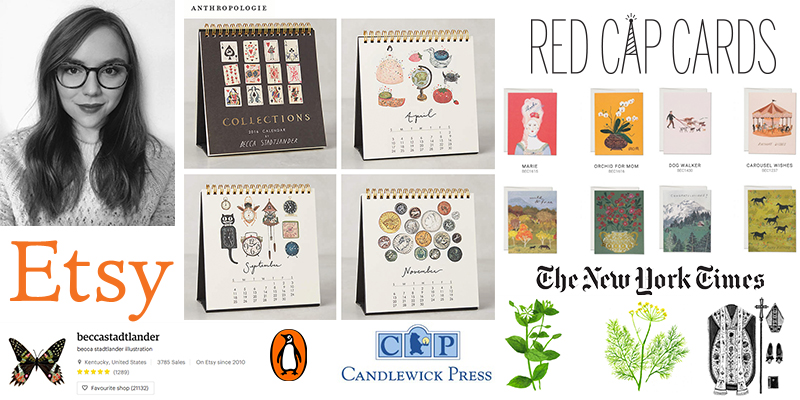
Pictured above is Becca with just a small handful of the clients she has worked with: Etsy, Anthropologie, The New York Times, Penguin, Candlewick Press and Red Cap Cards. The great thing about illustration is how transferable your skill set can be.
David, with a book like The Bear and the Piano, how much involvement was there from your agent in terms of development and how do you feel about direction from an agent – do you find it works for you, or do you feel that as the artist, the layout and composition of a book should be very much your decision?
[David] What I discovered when creating The Bear & The Piano is that it’s a lot like filmmaking, in that when you watch E.T. or Jaws, you are apparently watching a film made by Steven Spielberg. But in the credits there are hundreds of other people who make that film what it is and how it looks and feels. The editor, the lighting department, the sound, the music. All these different people offering input into the final movie.
And that is a bit like creating books — albeit with a fair few less people involved.
My main agent Anne Moore Armstrong was instrumental in bringing the book to life. Her encouragement and ideas were invaluable, and obviously she got me my very first pitch meeting with publishers in the first place.
My editor at Frances Lincoln, Katie Cotton, helped me hone the story so it was as perfect as we could make it and again offered so much advice on pacing and characters. The book designer Andrew Watson gave me incredible guidance in terms of layout and composition and in fact came up with the idea for the opening spread which is the bear cub finding the piano. I originally sketched this scene out in panels with the Bear taking ages to approach the piano and really dragging it out and cluttering up the first pages of the book.
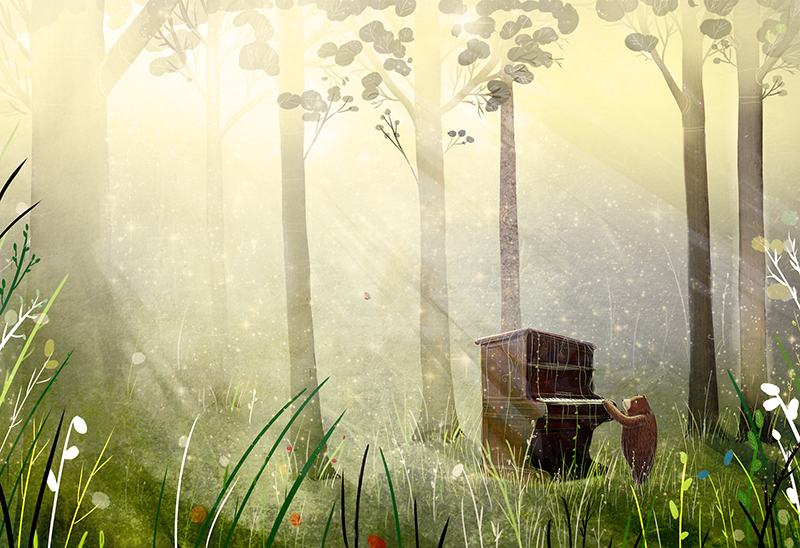
Andrew’s idea to simplify it into one image was great and created the perfect opening for the book.
So, yes it was a total collaboration between the dream team of Anne, Katie and Andrew as well as a fair few others too.
What advice would you give to art students now?
[Nicola] Be professional. Show up to class on time, get your work in on time, take feedback, have a website, don’t say things on social media you might later regret. Be proactive in improving your portfolio and finding work opportunities. When I was a student, I did not fully appreciate how busy people are, so if someone takes time to help you, thank them for it. Also – don’t send clone emails to multiple people. They are easy to spot and if you can’t be bothered to research and send a personal email, you can bet that the person receiving it won’t bother to reply.
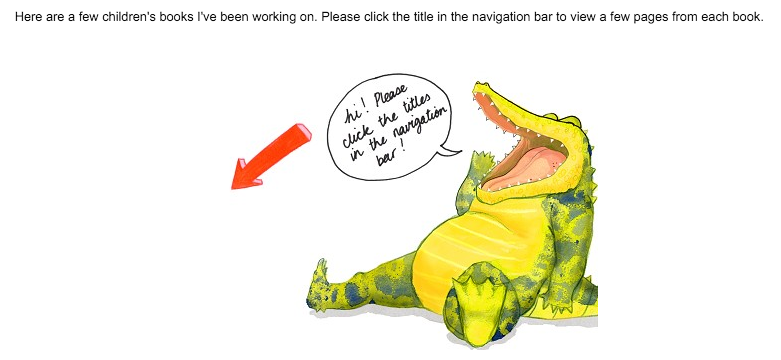
Click here to go to Nicola’s website.
[Becca] Don’t get too caught up in what other people are doing. It’s so easy to go on social media and see other people’s work and get discouraged. Looking at what inspires you is wonderful and might give you the kick in the pants you need to get going, but your career path will be unique to you and too much comparing will only bring you down.
Oh — and always be nice. The illustration world is smaller than you think. A client that you do something small for now might give you a big job later if you act graciously and treat them with respect.
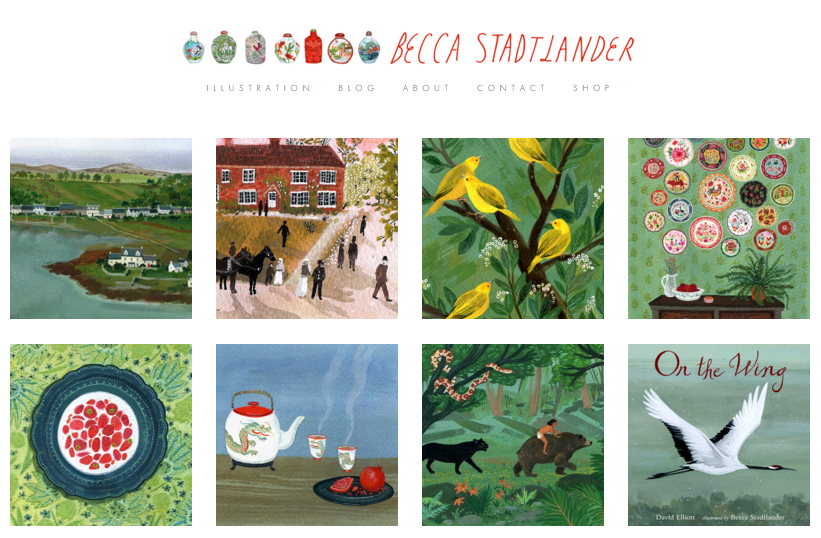
Click here to go to Becca’s website.
David Litchfield Studied at Bedford College: @bedfordcollege and Camberwell College of Art: @CamberwellUAL Nicola O’Byrne at Edinburgh College of Art: @eca_edinburgh And Becca Stadtlander at The Maryland Institute College of Art: @mica_alumni
Do you ever get writers/artists block?
[David] Yes I do. But drawing in my sketchbook for a few hours usually gets the creative cogs moving and the ideas flowing again. (See David’s drawing a day blog for inspiration here)
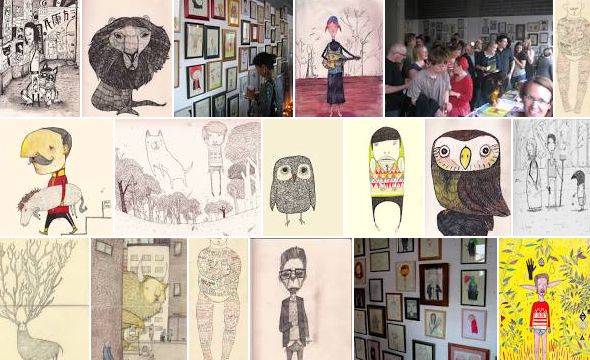
David Litchfield held an exhibition in his home town of Bedford after completing all 365 drawings over the space of a year.
[Nicola] All the time. It used to really stress me out – every time it happened I’d think rather dramatically, “well that’s it, my career is over!” But now I know that I always go through periods of being stuck followed by periods of high activity. It’s ok. Be kind to yourself. Go for a walk, try sketching somewhere new, or doing a fun illustration or writing activity that isn’t directly linked to whatever you’re trying to do. Failing that, I sit at my desk and don’t leave until I have something — anything! Then I try again the next day.
[Becca] Yes, I go through phases where I feel sort of uninspired and crumple up most of my sketches. It’s always a struggle, but what almost always works for me is to just step away. The joy of working from home is that you have the freedom to walk away sometimes. When I’m not in the mood to paint, everything comes out labored and wrong. It doesn’t mean that I don’t love what I do, but when I’m trying way too hard I know I need a break.
What were the benefits for you in joining an agency like Bright?
[David] Joining Bright has given me so many more opportunities that just wouldn’t have been possible before. The knowledge they have of the publishing industry has been invaluable for me in terms of tailoring my portfolio. Also the connections they have made within the publish industry in the U.K, America and globally has meant that my portfolio has been seen by people I just wouldn’t have dreamt of before signing to Bright.
Having Anne, Vicki,and the rest of the gang in my corner has been incredible and I really do owe them so much in terms of how my work has gone.

Click here to go to David’s website.
[Nicola] Bright has been hugely beneficial for me. Initially I needed direction to fine tune (and in places, completely overhaul) my portfolio. Then, I needed Bright to set me up with publishers willing to take on inexperienced, debut author/ illustrators. I needed Bright to find me small jobs that would pay my bills while I was developing. Then, I needed the help of the agents who double as editors and art directors when I am stuck, and as financial, contract and legal advisors, when I have occasionally had those kinds of issues.
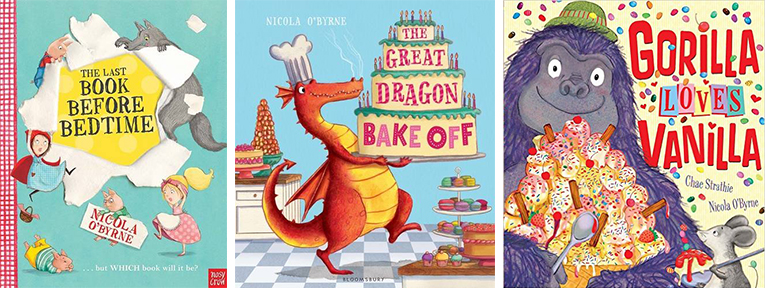
Nicky’s recognisable style on her author/illustrated titles The Last Book Before Bedtime, published by Nosy Crow: The Great Dragon Bake Off, published this July by Bloomsbury and featuring a dragon called Flamie Oliver, who has a penchant for pastry! A fantastic collaboration with author Chae Strathie for Gorilla Loves Vanilla, published earlier this year by Scholastic.
Illustration is my dream job — and it can be very competitive and difficult. Recently I went to Bologna Book Fair for the first time and realised the scale of what people trying to break into publishing are up against. I’m an introverted person. I like small, friendly meetings, followed by tea and cake. I have this with Bright. My agent Vicki is more like a mentor to me, and Hannah and Amanda are a brilliant art licensing team. And all the other wonderful people at Bright who day to day make everything easier for me and take care of things so that I can just work on what I love doing best.
As my relationship with Bright has matured — at the risk of sounding cheesy — I do feel like part of a family. Particularly what I appreciate about Bright over other agencies, is that they take on and nurture new talent. This is an expensive and time costly thing for them to do, but I think, so worthwhile. After all, that was me five years ago!
[Becca] I think it’s a little hard to break into the children’s book world without an agent, so I’m glad to have had Bright help me find my niche there. I’m happy to say that I’ve signed on for more than a few book projects that I’ve been thrilled with. It’s also nice to know that I have people on my side, to help negotiate all the business side of illustration that it’s easy to feel overwhelmed by. A freelance lifestyle can be pretty isolating, so being in constant communication with the agency has been great for boosting my morale.

Nicola O’Byrne and David Litchfield with their Waterstones Book Prize wins for Open Very Carefully, Published by Nosy Crow: the 2014 winner, and The Bear and the Piano, published by Frances Lincoln: the 2016 winner. Bottom row: Nicky pictured with her fellow winners: Katherine Rundell for Rooftoppers, published by Simon and Schuster (Best Fiction 5 to 12s & overall winner) & Holly Smale for Geek Girl, published by Harpercollins (Best book for Teens). And David pictured with Bright Founder and MD, Vicki Willden-Lebrecht.
Thank you to David, Nicky, Becca and Anne for your wonderful and insightful contributions to this blog series. To our readers; we hope you feel inspired, and to anyone thinking about a career in the picture book industry — go for it. You won’t know unless you try. One thing to bear in mind is that distance is no object, age no barrier and your creativity is a real gift. So share it!

From Becca Stadtlander’s blog.
If you’d like to work with the artists featured in this blog, you can reach us via email here.
Follow David, Nicky and Becca via twitter:
@dc_litchfield @NicolaOByrne1 @rhstadtlander
Creative Agent, Anne Moore Armstrong is based in the USA and you can reach her via Twitter @childbookart
If you’re an artist looking for representation we’d love to hear from you. Get in touch here.